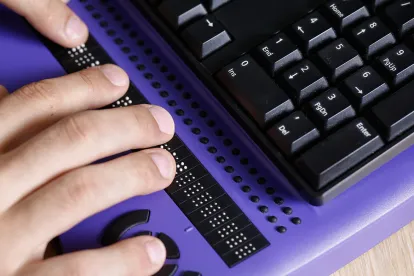After nearly ten years, on Tuesday, June 5, 2018, the World Wide Web Consortium (the “W3C”), the private organization focused on enhancing online user experiences, published the long awaited update to its Web Content Accessibility Guidelines 2.0 (“WCAG 2.0”), known as the WCAG 2.1. Those who have been following along with website accessibility’s ever-evolving legal landscape are well aware that, despite not having been formally adopted by regulators for the vast majority of the private sector, compliance with WCAG 2.0 at Levels A and AA has become the de facto baseline for government regulators, courts, advocacy groups, and private plaintiffs when discussing what it means to have an accessible website.
WCAG 2.1’s Purpose and Key Features
The WCAG 2.1 is intended to provide a better web experience for three major groups of individuals: users with cognitive or learning disabilities, users with low vision, and users with disabilities using mobile devices. To achieve that goal, WCAG 2.1 builds upon WCAG 2.0, retaining all of WCAG 2.0’s Success Criteria and adding 17 new Success Criteria – 5 at Level A, 7 at Level AA, and 5 at Level AAA. (Please note: (i) the W3C does not recommend Level AAA conformance be required as a general policy for entire sites because it is not possible to satisfy all Level AAA Success Criteria for some content; and (ii) the current legal landscape sets website accessibility compliance at the Level A and AA conformance levels.) Entities covered by Title III of the Americans with Disabilities Act (“ADA”), thus focusing on complying with WCAG 2.0/2.1 conformance levels A and AA to make their websites accessible, should be aware that, of the 12 Level A and AA Success Criteria new to WCAG 2.1, there a few notable guidelines that will specifically apply to desktop websites, such as:
- Requiring the purpose of input fields requesting personal information to be identifiable by assistive technologies;
- Providing a minimum color contrast ratio for non-text content (including all visible focus indicators) of 3:1;
- Ensuring individuals with disabilities who choose to override spacing can read page text;
- Modifying keyboard shortcuts so that individuals with disabilities can turn off or remap the shortcut using a non-printable keyboard character (e.g., Ctrl, Alt, etc.); and
- Providing status messages (such as, shopping cart updates) that can be presented to the user by assistive technologies without receiving focus.
What WCAG 2.1 Means For Those Currently Complying With WCAG 2.0
As noted above, while formal website accessibly regulations governing all sectors of private business have not been adopted by the U. S. Department of Justice (“DOJ”) (and current Trump administration policies suggest that formal regulations will not be adopted in the near-term future), substantial conformance with WCAG 2.0 Levels A and AA has been considered the default standard cited to in the majority of recent litigations and settlement agreements with private plaintiffs, advocacy groups, and government regulators (e.g., DOJ). In its abstract, the W3C notes, “The publication of WCAG 2.1 does not deprecate or supersede WCAG 2.0. While WCAG 2.0 remains a W3C Recommendation, the W3C advises the use of WCAG 2.1 to maximize future applicability of accessibility efforts.” Therefore, as WCAG 2.1 gains more exposure we expect that it will quickly begin to replace WCAG 2.0 as the default standard cited to in future website accessibility litigations and settlement agreements.
Companies that are currently required to conform with WCAG 2.0 (e.g., due to a settlement agreement, internal policy, etc.) should continue their efforts to achieve that required level of accessibility, however, where possible, they should also consider incorporating the new elements added to WCAG 2.1 to the extent feasible (and going forward as new content is added) as a best practice. (The W3C joins in this recommendation.) As WCAG 2.1 inherited WCAG 2.0’s requirements and overall structure and frame work, companies will be able to update web content to meet the WCAG 2.1 without losing conformance with WCAG 2.0 (as the backward compatibility built into WCAG 2.1 means content that conforms to WCAG 2.1 also conforms to WCAG 2.0). That said, given that WCAG 2.0/2.1 remain privately authored guidelines as opposed government-mandated regulations (and, as such, a handful of courts have refused to specifically impose WCAG 2.0 as the required means of complying with website accessibility obligations), we would be surprised to see courts require companies already complying with WCAG 2.0 to immediately require compliance with WCAG 2.1.
WCAG 2.1 Is Not Quite the Update Places of Public Accommodation Have Been Looking For
While the publication of WCAG 2.1 will likely receive a reasonable amount of fanfare, once the dust settles and everyone has had time to fully appreciate its content, WCAG 2.1 will likely be considered a let down by both businesses and individuals with disabilities. As WCAG 2.1 was being drafted over the past four years, the W3C would regularly offer open comment periods to the public. In the comments received, a large number of respondents requested, even moreso than adding new Success Criteria, that WCAG 2.1 provide updates to the original WCAG 2.0 requirements to help developers apply these guidelines to the newest types of technologies (e.g., touch screen, mobile devices, apps, responsive technology, etc.). Unfortunately, due to time limitations, such updates are not included in WCAG 2.1 and the original WCAG 2.0 Success Criteria text remains largely unchanged. The W3C has publically acknowledged this shortcoming noting the WCAG 2.1 advancements are “incremental” and stating, “[m]any people hoped WCAG 2.1 would provide more new guidance than it does. The requirement of compatibility with WCAG 2.0 along with the aggressive timeline limited what could confidently be added to it. WCAG 2.1 provides important and timely guidance but is still only a step—the Working Group expects to develop another dot-release, WCAG 2.2, to expand the new coverage even further. WCAG 2.2 may be developed under a similar timeline and requirements set than WCAG 2.1 was, though we plan to refine the process to address process challenges experienced during the development of WCAG 2.1.” Therefore, at this time, companies looking for additional guidance regarding how to apply the WCAG 2.0 requirements using modern programming and design techniques and/or to mobile devices/apps should continue to refer to other sources of guidance such as:
- https://www.w3.org/TR/mobile-accessibility-mapping/
- https://www.w3.org/WAI/standards-guidelines/mobile/
- https://www.w3.org/Mobile/roadmap/
- http://www.bbc.co.uk/guidelines/futuremedia/accessibility/mobile
- https://developer.android.com/training/accessibility/testing
- https://developer.apple.com/accessibility/ios/
Looking Forward
While an additional dot release of WCAG 2 (WCAG 2.2) may be published in the future, the next major version update to WCAG will be WCAG 3.0 (also known as project “Silver”). Currently, WCAG 3.0 is scheduled for release in 2021 and is intended to be a much more inclusive set of guidelines that are easier to understand and implement. We will provide additional information on WCAG 3.0 developments as they become available.
Additional Information and Resources
In anticipation of the WCAG 2.1 release, the W3C has completely updated its website to create a helpful, easy to use, interface intended to assist website developers with meeting the WCAG 2.0/2.1 guidelines. This new information provided on the updated W3C website includes: a list of transcription services (for creating videos with audio descriptions), WCAG 2.0/2.1 tutorials, and information for applying WCAG 2.0/2.1 to mobile apps.




 />i
/>i

